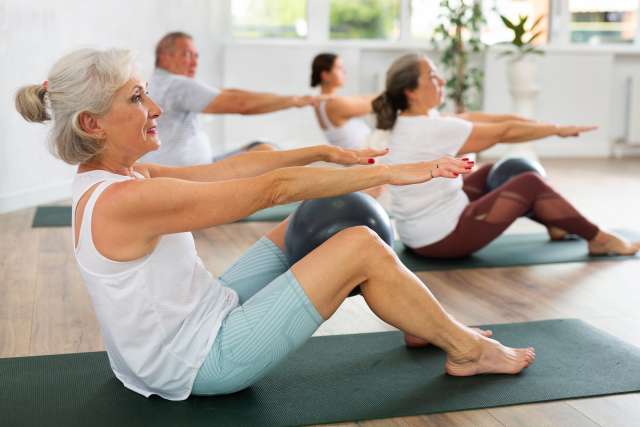Healthy aging and exercise go hand in hand. But if your body doesn’t move like it used to, you may feel limited in your options for safe and effective workouts. Pilates may be the answer.
Pilates continues to rise in popularity, and for good reason. It requires little to no equipment and is adaptable to all ages and fitness levels. Pilates is an especially good option for older adults, because it provides maximum benefits without high impact.
Here’s what you need to know about Pilates:
What is Pilates?
Pilates is a low-impact exercise format involving repetitive movements that work your muscles and require focus. Think , but instead of holding poses, you continue to move your arms or legs.
Pilates exercises are based on six core principles:
- Center
- Concentration
- Control
- Precision
- Fluidity
- Breathing
Pilates movements — initially developed in the 1920s for physical rehabilitation — target the deep muscles that help stabilize the core and joints. The and challenge in Pilates come from body weight and changing body position.
One advantage of Pilates is its flexibility. You can do it on a mat or using special equipment. The exercises are also adaptable, ranging from gentle strength training to a vigorous workout.
Benefits of Pilates
Aging affects every function in your body, including mental health. But can slow down that decline. Pilates has specific benefits for healthy aging, including:
1. Reduces your fall risk
Muscle strength naturally declines as you age. If you don’t work to maintain it, the loss can soon affect your and mobility — two major risk factors for falling.
Pilates can lower your fall risk by improving:
- Muscle strength: Research shows that people who do Pilates often see significant increases in their strength. One found that older people who practiced Pilates for four weeks had noticeable increases in core strength and balance.
- Balance: Pilates helps with dynamic balance — the balance you need when moving. shows that Pilates may be more effective for than general physical exercise. When people 65 and older use a Pilates reformer (equipment that looks like a platform on wheels) just once a week, they may see improved balance and mobility in 10 weeks.
- Gait: How quickly you walk (gait) can be used as an indicator of fall risk. Pilates builds lower limb strength that lends itself to better balance and walking ability.
2. Supports good posture
Hunching or can be an obvious sign of aging. Muscles support your spine, and your spinal bones help keep you upright. If those two supports start to decline, it may affect your posture.
Pilates exercises require you to contract (pull in) the muscles in your lower abdomen (transversus abdominis). When you do that, you naturally contract — and strengthen — the long, narrow muscles (lumbar multifidus) on either side of your spine. Those contractions are also good for your pelvic floor muscles and diaphragm, which help maintain abdominal pressure. By strengthening your entire core in this way, you can achieve solid spinal support.
Keeping your bones strong is another way to support your spine health. If the bones in your spine weaken or collapse, it affects your posture. Some smaller studies suggest that Pilates helps to maintain bone density as you age.
3. Decreases your risk of chronic disease
It’s well-established that regular exercise helps protect against chronic diseases. But some shows that Pilates performed on a mat may be more effective than traditional resistance training at reducing specific weight-related risk factors. It may lower abdominal circumference (the distance around your waist) and body mass index (BMI).
A higher BMI raises your risk for several chronic diseases, including:
Your waist measurement is also important. Having a lot of fat around your middle puts you at higher risk for heart disease and Type 2 diabetes. The risk increases if your waist measurement is greater than 35 inches (for people assigned female at birth) or greater than 40 inches (for people assigned male at birth).
4. Improves your emotional health
Your sense of well-being plays a critical role as you age. It can affect your desire to socialize, your mood and your motivation to make healthy choices. show that practicing Pilates can improve your:
- Life satisfaction
- Perception of health
- Quality of life
In addition to moving your body, Pilates incorporates focused breathing and concentration, possibly even mimicking the .
Tips for Pilates beginners
Ready to give Pilates a try? Before you do, here are some tips for safe and successful Pilates practice:
- Consult your primary care physician (PCP): Before you start any new exercise program, it’s always a good idea to check in with your PCP. They’ll know if Pilates is a safe option for you.
- Modify exercises if you have : If your bones are weak, avoid Pilates exercises that include deep twists, putting pressure on your rib cage and rounding or flexing your spine.
- Look for Pilates classes for older adults: Classes meant for people 60 and older will consider your age and tailor exercises to this population’s balance challenges, mobility and joint limitations.
- Choose a Pilates format you enjoy: It doesn’t matter whether you prefer to exercise on a mat or using Pilates equipment. shows that both provide significant and similar functional improvements for older adults.



